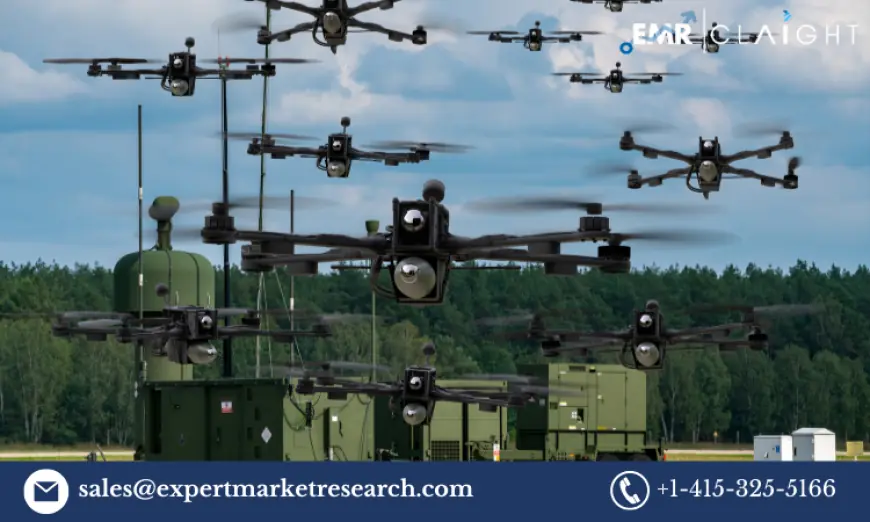Military Robots Market Size, Share, Trends, and Forecast 2025-2034
Military Robots Market

The global military robots market size is expanding rapidly as defense forces increasingly adopt autonomous and unmanned systems for combat, surveillance, logistics, and intelligence operations. The integration of artificial intelligence (AI), robotics, and advanced weaponry is revolutionizing modern warfare, making military robots an essential component of defense strategies worldwide.
In 2024, the global military robots market was valued at USD 20,804.93 million, and it is projected to grow at a CAGR of 8.1% between 2025 and 2034, reaching approximately USD 41,938.31 million by 2034. Rising geopolitical tensions, growing defense budgets, and advancements in robotic warfare are driving market expansion.
This blog explores the market dynamics, key drivers, challenges, trends, and future opportunities shaping the global military robots industry.
Market Overview
Military robots enhance combat efficiency, minimize risks to soldiers, and improve operational capabilities in war zones and security operations. These robots perform various tasks, including:
- Unmanned reconnaissance and surveillance
- Combat support and autonomous weapon systems
- Explosive ordnance disposal (EOD) and demining operations
- Logistics and battlefield medical assistance
The adoption of AI-driven decision-making, machine learning algorithms, and cyber-defense technologies is transforming military robots into fully autonomous and highly effective war machines.
Key Market Drivers
Several factors are fueling the growth of the global military robots market:
1. Increasing Demand for Autonomous Warfare Systems
Modern military strategies emphasize unmanned and autonomous warfare, reducing the need for human intervention in high-risk combat zones. AI-powered drones, robotic tanks, and self-driving combat vehicles are becoming integral to defense operations.
2. Rising Defense Budgets and Military Modernization Programs
Governments are increasing defense spending to enhance their military capabilities and develop cutting-edge robotic systems. Countries like the United States, China, Russia, and India are investing heavily in AI-driven combat robots, surveillance drones, and robotic ground vehicles.
3. Growing Need for Border Security and Counterterrorism Operations
The rise in cross-border conflicts, insurgencies, and terrorist activities is driving the deployment of unmanned surveillance drones and AI-powered security robots. Military robots assist in monitoring border areas, detecting threats, and neutralizing enemy forces.
4. Advancements in AI, Machine Learning, and Robotics Technology
AI and robotics innovations are improving military robot efficiency, decision-making, and adaptability. Self-learning algorithms, real-time data processing, and swarm intelligence are enhancing the combat capabilities of robotic systems.
5. Deployment of Military Robots for Logistics and Medical Assistance
Robotic systems are increasingly used for transporting ammunition, supplies, and medical aid in war zones. Autonomous medevac robots and drone ambulances help evacuate injured soldiers without risking human lives.
6. Increasing Use of Unmanned Aerial Vehicles (UAVs) in Combat and Reconnaissance
Unmanned aerial vehicles (UAVs), or military drones, play a crucial role in intelligence gathering, surveillance, and targeted airstrikes. High-altitude long-endurance (HALE) drones and swarm drones are redefining modern warfare strategies.
Market Challenges
Despite its rapid growth, the military robots market faces several challenges:
1. High Development and Deployment Costs
Military robots require significant R&D investment, advanced software integration, and expensive hardware components. These factors contribute to high procurement costs, limiting adoption in budget-constrained defense sectors.
2. Ethical and Legal Concerns Regarding Autonomous Combat Systems
Fully autonomous combat robots raise ethical and legal challenges, including the lack of human oversight in lethal decision-making. International organizations are debating the regulation of AI-powered warfare to ensure accountability.
3. Cybersecurity Threats and Hacking Risks
Military robots rely on AI, wireless networks, and cloud-based intelligence for operations, making them vulnerable to cyberattacks, GPS jamming, and electronic warfare. Defense forces must develop strong cybersecurity measures to protect robotic systems from hacking.
4. Technical Limitations in Autonomous Navigation and AI Decision-Making
While AI-powered military robots are advancing, navigation, object recognition, and target identification still require continuous improvements. Military robots must adapt to unpredictable combat environments with minimal errors.
5. Public Opposition to AI-Powered Weapon Systems
The use of killer robots and AI-driven combat drones has sparked global debates about humanitarian concerns and warfare ethics. Public and political resistance may influence future defense policies regarding fully autonomous weapons.
Key Market Trends
Several emerging trends are shaping the future of the global military robots industry:
1. Integration of AI and Swarm Robotics in Military Operations
AI-powered swarm drones and robotic fleets enhance battlefield coordination, enabling autonomous attacks, surveillance missions, and formation-based combat strategies.
2. Development of Stealth and Underwater Military Robots
Navies are deploying autonomous underwater vehicles (AUVs) and unmanned surface vessels (USVs) for submarine detection, mine clearance, and maritime reconnaissance.
3. Growth of Counter-Drone and Anti-Robot Warfare Technologies
As robotic warfare evolves, defense forces are investing in anti-drone lasers, electromagnetic pulse (EMP) weapons, and AI-driven cyber-defense systems to counter enemy robots.
4. Expansion of Space-Based Military Robotics and Satellite Defense
Countries are developing robotic space vehicles, orbital surveillance drones, and satellite-based ISR (Intelligence, Surveillance, and Reconnaissance) systems for space warfare and global defense strategies.
5. Miniaturization and Lightweight Military Robots
Manufacturers are focusing on compact, lightweight, and energy-efficient robots that enhance mobility and deployment flexibility in urban warfare and counterinsurgency operations.
6. Use of Hybrid and Renewable Energy-Powered Military Robots
To reduce dependency on fossil fuels, military robots are integrating solar, hydrogen fuel cell, and battery-powered propulsion systems for longer operational endurance.
Market Segmentation
The global military robots market is segmented based on type, application, and region.
1. By Type
- Unmanned Aerial Vehicles (UAVs) – Drones used for surveillance, combat, and intelligence gathering.
- Unmanned Ground Vehicles (UGVs) – Includes robotic tanks, bomb disposal robots, and ground-based combat vehicles.
- Autonomous Underwater Vehicles (AUVs) – Used in naval defense, submarine tracking, and maritime security.
2. By Application
- Reconnaissance & Surveillance – ISR (Intelligence, Surveillance, and Reconnaissance) drones and robotic scouts.
- Combat Operations – Autonomous weaponized robots and AI-driven combat vehicles.
- Explosive Ordnance Disposal (EOD) – Robots for mine detection and bomb disposal.
- Search & Rescue – Military rescue robots for battlefield evacuation and medical assistance.
3. By Region
- North America – Leading market due to strong defense budgets and advanced robotic warfare technology.
- Europe – High investment in autonomous ground vehicles and counterterrorism robots.
- Asia-Pacific – Fastest-growing region, driven by rising military expenditures in China, India, and Japan.
- Middle East & Latin America – Increasing demand for border security and surveillance robots.
Future Outlook (2025-2034)
The military robots industry will continue evolving with AI-driven warfare, autonomous decision-making, and next-generation robotic combat units. Key developments expected in the coming years include:
- Expansion of robotic swarm intelligence in battlefield coordination.
- Advancements in AI-powered counterterrorism and cyber-defense robots.
- Deployment of quantum computing for enhanced military decision-making.
- Growth in hybrid and renewable energy-powered autonomous robots.
With the global shift towards automation, defense modernization, and AI-driven warfare, the military robots market will play an increasingly dominant role in global defense strategies.
What's Your Reaction?
 Like
0
Like
0
 Dislike
0
Dislike
0
 Love
0
Love
0
 Funny
0
Funny
0
 Angry
0
Angry
0
 Sad
0
Sad
0
 Wow
0
Wow
0
















































